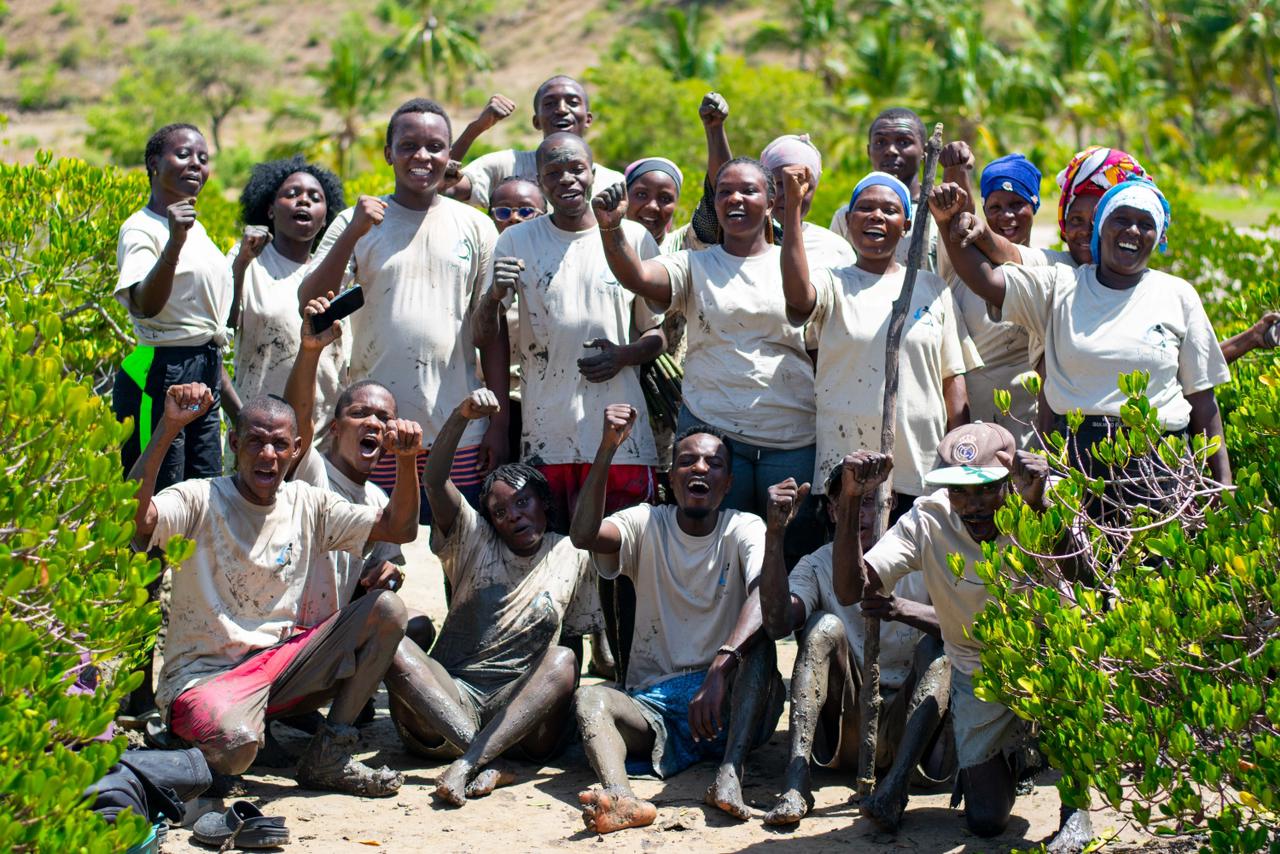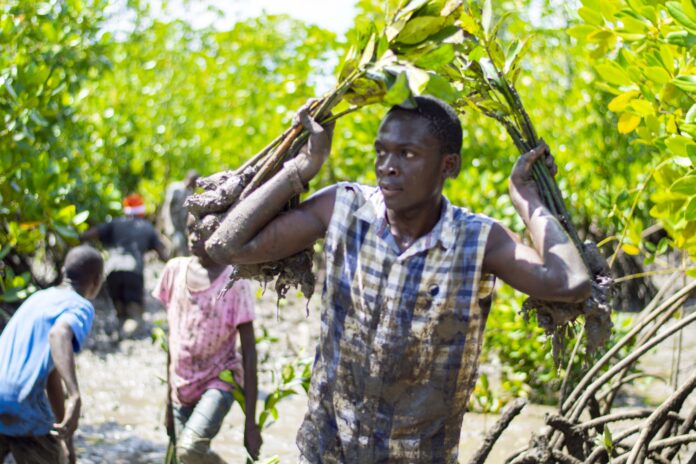By Mary Mwendwa
Nairobi, Kenya: As the world gathers for the 6th United Nations Environmental Assembly(UNEA) from 26th – 1st March 2024 in Nairobi, at United Nations Environment Program (UNEP) headquarters, discussions around humanity and nature have not missed the stage. Tackling biodiversity loss that has had adverse effects on the environment has led to a group in Mombasa County restoring mangroves through a community empowerment project. Steve Misati is the Founder and director of Youth Pawa organization. Talkafrica talked to him about their work in mangrove restoration on the Kenya coast.
When was the mangroves restoration project started?
The Mangrove Eco-Restoration project was started and launched in February 2022. The project is situated in the Mkupe area, in Miritini ward, Mombasa, Kenya. The project has 33 community members who have been registered as project ground personnel, gaining valuable skills and resource opportunities. For the years, we’ve been able to host several workshops in the local area, we’ve also involved 612 volunteers both youths and the local people thus fostering strong bonds and partnerships.
Kindly talk briefly about the importance of mangroves to the ecosystem and why they need to be protected.
I’d say, imagine a coastal ecosystem bustling with life, protecting communities, and filtering the earth’s breath. Well, that’s the magic of mangroves. They are lifeline ecosystems, playing critical roles in both the environment and the lives of the people on the coast. From providing crucial habitat for fish, crustaceans, and countless other marine species, to filtering pollutants from water through their roots, they ensure the health of the entire ecosystem is intact. Not even forgetting how they act as a shield against storms, protecting the coastline from erosion and buffering communities from floods.
Sadly, these crucial ecosystems are disappearing at an alarming rate, threatened by human activities like deforestation and pollution. This has devastating consequences, not just for the irreplaceable marine life they support, but also for the communities that rely on them. Furthermore, losing mangroves means losing natural barriers against storms, increasing vulnerability to climate change, and disrupting the delicate balance of the coastal ecosystem.
That’s why restoration projects like ours are so crucial. We are actively planting and rebuilding these vital ecosystems, not just for nature’s sake, but for the well-being of generations to come. I believe through the restoration of mangroves, we are investing in a healthier planet, resilient communities, and a sustainable future for all.
In terms of climate change mitigation measures, what role do mangroves play?
Mangroves, which I usually refer to asHY the “Green lungs of the Coast” play a crucial role in mitigating climate change. They act as powerful carbon sinks, storing up to five times more carbon per hectare than terrestrial forests. Their amazing yet complex root systems trap and accumulate sediment, creating a rich carbon store that can remain locked away for millennia. This natural carbon sequestration process helps offset greenhouse gas emissions, slowing the pace of global warming.
Beyond carbon sequestration, mangroves offer other climate mitigation benefits. Their lush and dense canopies act as windbreaks, protecting coastal communities from storm surges and flooding, which become increasingly intense with climate change. Additionally, they act as natural filters, purifying water, and stabilizing coastlines, reducing erosion and shielding infrastructure from rising sea levels. In essence, mangroves are a nature-based solution to climate change, providing a vital natural defense system against climate change impacts, and making them invaluable allies in our fight for a more stable planet.
What are some of the threats the Indian Ocean faces and how do you address them through this project?
The Indian Ocean faces numerous threats. From overfishing which depletes vital marine populations, to plastic pollution that chokes its ecosystems such as mangroves, coral reefs, and seagrass, to climate change which fuels extreme weather events, that in turn intensifies storms and alters ocean currents, disrupting ecosystems and increasing coastal erosion. Furthermore, unsustainable practices like mangrove deforestation which happens along the coast further increase these issues, robbing the ocean of its natural defenses and biodiversity.
Our project tackles these challenges head-on, promoting a nature-based solution to multiple threats. By planting and nurturing mangrove trees, we create vital nurseries for fish and crustaceans, replenishing overexploited populations and supporting local fisheries. Restoring degraded areas also increases the ocean’s natural carbon sequestration capacity, mitigating the impacts of climate change. Lastly, with the restoration and conservation going on, the mangroves can be supported to continue their work as natural buffers against storms and rising sea levels, protecting coastal communities and infrastructure.
Additionally, our project empowers the local community, fostering ownership and participation in conservation efforts. This ensures long-term sustainability creates positive impacts, and inspires others to adopt sustainable practices.

What benefits have you seen so far in regard to the group activities in restoring mangroves?
Our project is actually a testament to the transformative power of collective action because, in just two years, we’ve witnessed remarkable progress, demonstrating the tangible benefits of community involvement in environmental restoration. In the course of the two years, we’ve managed to plant 19,622 mangroves, bringing life back into 8.5 degraded mangrove areas so far. And this wouldn’t have been possible without the dedication of the individuals and community, with whom we have worked together over the course of the years.
And with these efforts, we are now witnessing a biodiversity comeback. We have seen lots of crabs, small fish, and other crustaceans such as oysters coming back into the ecosystem. We have also witnessed butterflies in the area 3 times, and this goes beyond to show what impacts can be brought about with restoration and conservation efforts.
Lastly, the local community has become active stewards of their environment by participating in and benefiting from the training sessions we usually hold that focus on mangrove conservation education and ocean literacy. This knowledge gained comes in handy in fostering a sense of ownership, crucial for the long-term sustainability of the project.
Do you work with other partners? if yes, who are they, and how do you collaborate?
We work with the Mombasa Kilindini Community Forest Association (MOCKIFA) which acts as the oversight of our restoration project. We have also been supported by The Iris Project, Sustainable Fisheries and Communities Trust (SFACT), and also Youth Ocean Conservation Summit (YOCS).














